Deck 3: Additional Derivative Topics
Question
Question
Question
Question
Question
Question
Question
Question
Question
Question
Question
Question
Question
Question
Question
Question
Question
Question
Question
Question
Question
Question
Question
Question
Question
Question
Question
Question
Question
Question
Question
Question
Question
Question
Question
Question
Question
Question
Question
Question
Question
Question
Question
Question
Question
Question
Question
Question
Question
Question
Question
Question
Question
Question
Question
Question
Question
Question
Question
Question
Question
Question
Question
Question
Question
Question
Question
Question
Question
Question
Question
Question
Question
Question
Question
Question
Question
Question
Question
Question

Unlock Deck
Sign up to unlock the cards in this deck!
Unlock Deck
Unlock Deck
1/126
Play
Full screen (f)
Deck 3: Additional Derivative Topics
1
Find f‛(x).

A)
B)
C)
D)

A)

B)

C)

D)


2
Solve the problem.
If $5000 is invested at 5.25% compounded continuously, what is the amount in the account after 10 years?
A) $8452.29
B) $8442.52
C) $7625.00
D) $7420.65
If $5000 is invested at 5.25% compounded continuously, what is the amount in the account after 10 years?
A) $8452.29
B) $8442.52
C) $7625.00
D) $7420.65
$8452.29
3
Solve the problem.
How long will it take for the value of an account to be $890 if $350 is deposited at 11% interest compounded continuously? Round your answer to the nearest hundredth.
A) 10.41 yr
B) 0.93 yr
C) 9.33 yr
D) 8.48 yr
How long will it take for the value of an account to be $890 if $350 is deposited at 11% interest compounded continuously? Round your answer to the nearest hundredth.
A) 10.41 yr
B) 0.93 yr
C) 9.33 yr
D) 8.48 yr
8.48 yr
4
Provide an appropriate response.
Find t to four decimal places.
A) -70.1312
B) -66.4815
C) 42.7962
D) 44.321
Find t to four decimal places.

A) -70.1312
B) -66.4815
C) 42.7962
D) 44.321

Unlock Deck
Unlock for access to all 126 flashcards in this deck.
Unlock Deck
k this deck
5
Provide an appropriate response.
Graph the function which calculates the present value of an amount of $5000 at an annual nominal rate of 7% compounded continuously for
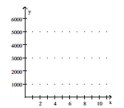
A)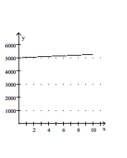
B)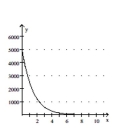
C)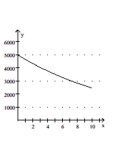
D)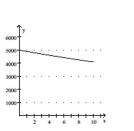
Graph the function which calculates the present value of an amount of $5000 at an annual nominal rate of 7% compounded continuously for


A)

B)

C)

D)


Unlock Deck
Unlock for access to all 126 flashcards in this deck.
Unlock Deck
k this deck
6
Find f‛(x).

A)
B)
C)
D)

A)

B)

C)

D)


Unlock Deck
Unlock for access to all 126 flashcards in this deck.
Unlock Deck
k this deck
7
Solve the problem.
What will the value of an account (to the nearest cent) be after 8 years if $100 is invested at 6.0% interest compounded continuously?
A) $159.38
B) $175.32
C) $161.61
D) $849.47
What will the value of an account (to the nearest cent) be after 8 years if $100 is invested at 6.0% interest compounded continuously?
A) $159.38
B) $175.32
C) $161.61
D) $849.47

Unlock Deck
Unlock for access to all 126 flashcards in this deck.
Unlock Deck
k this deck
8
Provide an appropriate response.
Find:
A) 5000
B)
C) 0
D) 1
Find:

A) 5000
B)

C) 0
D) 1

Unlock Deck
Unlock for access to all 126 flashcards in this deck.
Unlock Deck
k this deck
9
Provide an appropriate response.
Find x to two decimal places.
A) 7813.95
B) 7975.01
C) 7831.95
D) 8320.50
Find x to two decimal places.

A) 7813.95
B) 7975.01
C) 7831.95
D) 8320.50

Unlock Deck
Unlock for access to all 126 flashcards in this deck.
Unlock Deck
k this deck
10
Provide an appropriate response.
A man with $9000 to invest puts the money into an account that earns 8% compounded continuously. Graph the corresponding present value function and calculate the number of years before the $9000 will be due in
Order for its present value to be $7000. Use the formula
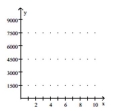
A)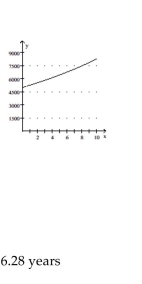
B)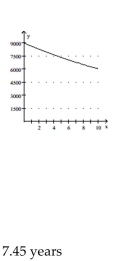
C)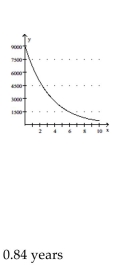
D)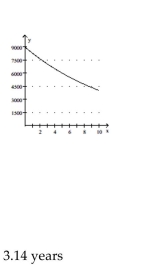
A man with $9000 to invest puts the money into an account that earns 8% compounded continuously. Graph the corresponding present value function and calculate the number of years before the $9000 will be due in
Order for its present value to be $7000. Use the formula


A)

B)

C)

D)


Unlock Deck
Unlock for access to all 126 flashcards in this deck.
Unlock Deck
k this deck
11
Find f‛(x).

A)
B)
C)
D)

A)

B)

C)

D)


Unlock Deck
Unlock for access to all 126 flashcards in this deck.
Unlock Deck
k this deck
12
Find f‛(x).

A)
B)
C)
D)

A)

B)

C)

D)


Unlock Deck
Unlock for access to all 126 flashcards in this deck.
Unlock Deck
k this deck
13
Solve the problem.
An investor buys 100 shares of a stock for $20,000. After 5 years the stock is sold for $32,000. If interest is compounded continuously, what annual nominal rate of interest did the original $20,000 investment earn?
(Represent the answer as a percent to three decimal places.)
A) 8.470%
B) 1.200%
C) 9.400%
D) 0.094%
An investor buys 100 shares of a stock for $20,000. After 5 years the stock is sold for $32,000. If interest is compounded continuously, what annual nominal rate of interest did the original $20,000 investment earn?
(Represent the answer as a percent to three decimal places.)
A) 8.470%
B) 1.200%
C) 9.400%
D) 0.094%

Unlock Deck
Unlock for access to all 126 flashcards in this deck.
Unlock Deck
k this deck
14
Solve the problem.
Suppose that $8000 is invested at an interest rate of 5.5% per year, compounded continuously. How long would it take to double the investment?
A) 12.6 yr
B) 11.6 yr
C) 2 yr
D) 13.6 yr
Suppose that $8000 is invested at an interest rate of 5.5% per year, compounded continuously. How long would it take to double the investment?
A) 12.6 yr
B) 11.6 yr
C) 2 yr
D) 13.6 yr

Unlock Deck
Unlock for access to all 126 flashcards in this deck.
Unlock Deck
k this deck
15
Find f‛(x).

A)
B)
C)
D)

A)

B)

C)

D)


Unlock Deck
Unlock for access to all 126 flashcards in this deck.
Unlock Deck
k this deck
16
Find f‛(x).

A)
B)
C)
D)

A)

B)

C)

D)


Unlock Deck
Unlock for access to all 126 flashcards in this deck.
Unlock Deck
k this deck
17
Solve the problem.
How long will it take for $8400 to grow to $14.600 at an interest rate of 9.4% if the interest is compounded continuously? Round the number of years to the nearest hundredth.
A) 0.59 yr
B) 0.06 yr
C) 58.81 yr
D) 5.88 yr
How long will it take for $8400 to grow to $14.600 at an interest rate of 9.4% if the interest is compounded continuously? Round the number of years to the nearest hundredth.
A) 0.59 yr
B) 0.06 yr
C) 58.81 yr
D) 5.88 yr

Unlock Deck
Unlock for access to all 126 flashcards in this deck.
Unlock Deck
k this deck
18
Provide an appropriate response.
Find t to four decimal places.
A) 2.9134
B) -2.8134
C) 2.6134
D) 2.8134
Find t to four decimal places.

A) 2.9134
B) -2.8134
C) 2.6134
D) 2.8134

Unlock Deck
Unlock for access to all 126 flashcards in this deck.
Unlock Deck
k this deck
19
Solve the problem.
Radioactive carbon-14 has a continuous compound rate of decay of r = -0.000124. Estimate the age of a skull uncovered at an archaeological site if 6% of the original amount of carbon-14 is still present. (Compute answer
To the nearest year.)
A) 124,027 yr
B) 20,032 yr
C) 22,689 yr
D) 470 yr
Radioactive carbon-14 has a continuous compound rate of decay of r = -0.000124. Estimate the age of a skull uncovered at an archaeological site if 6% of the original amount of carbon-14 is still present. (Compute answer
To the nearest year.)
A) 124,027 yr
B) 20,032 yr
C) 22,689 yr
D) 470 yr

Unlock Deck
Unlock for access to all 126 flashcards in this deck.
Unlock Deck
k this deck
20
Solve the problem.
How long will it take money to double if it is invested at 5.25%, compounded continuously? Round your answer to the nearest tenth.
A) 0.13 yr
B) 14 yr
C) 13.2 yr
D) 26.4 yr
How long will it take money to double if it is invested at 5.25%, compounded continuously? Round your answer to the nearest tenth.
A) 0.13 yr
B) 14 yr
C) 13.2 yr
D) 26.4 yr

Unlock Deck
Unlock for access to all 126 flashcards in this deck.
Unlock Deck
k this deck
21
Find the equation of the line tangent to the graph of f at the indicated value of x.
f(x) = 5 ln x; x = 1
A) y = 5x - 1
B) y = 5x + 5
C) y = 5x
D) y = 5x - 5
f(x) = 5 ln x; x = 1
A) y = 5x - 1
B) y = 5x + 5
C) y = 5x
D) y = 5x - 5

Unlock Deck
Unlock for access to all 126 flashcards in this deck.
Unlock Deck
k this deck
22
Find the equation of the line tangent to the graph of f at the indicated value of x.

A)
B)
C)
D)

A)

B)

C)

D)


Unlock Deck
Unlock for access to all 126 flashcards in this deck.
Unlock Deck
k this deck
23
Find f‛(x).

A)
B)
C)
D)

A)

B)

C)

D)


Unlock Deck
Unlock for access to all 126 flashcards in this deck.
Unlock Deck
k this deck
24
Find f‛(x).

A)
B)
C)
D)

A)

B)

C)

D)


Unlock Deck
Unlock for access to all 126 flashcards in this deck.
Unlock Deck
k this deck
25
Find  for the indicated function y.
for the indicated function y.

A)
B)
C)
D)
 for the indicated function y.
for the indicated function y.
A)

B)

C)

D)


Unlock Deck
Unlock for access to all 126 flashcards in this deck.
Unlock Deck
k this deck
26
Find the equation of the line tangent to the graph of f at the indicated value of x.

A) y = 2x + 2
B) y = 2x - 2
C) y = x + 2
D) y = 2x

A) y = 2x + 2
B) y = 2x - 2
C) y = x + 2
D) y = 2x

Unlock Deck
Unlock for access to all 126 flashcards in this deck.
Unlock Deck
k this deck
27
Find f‛(x).

A)
B)
C)
D)

A)

B)

C)

D)


Unlock Deck
Unlock for access to all 126 flashcards in this deck.
Unlock Deck
k this deck
28
Find  for the indicated function y.
for the indicated function y.

A)
B)
C)
D)
 for the indicated function y.
for the indicated function y.
A)

B)

C)

D)


Unlock Deck
Unlock for access to all 126 flashcards in this deck.
Unlock Deck
k this deck
29
Find  for the indicated function y.
for the indicated function y.

A)
B)
C)
D)
 for the indicated function y.
for the indicated function y.
A)

B)

C)

D)


Unlock Deck
Unlock for access to all 126 flashcards in this deck.
Unlock Deck
k this deck
30
Find  for the indicated function y.
for the indicated function y.

A)
B)
C)
D)
 for the indicated function y.
for the indicated function y.
A)

B)

C)

D)


Unlock Deck
Unlock for access to all 126 flashcards in this deck.
Unlock Deck
k this deck
31
Find  for the indicated function y.
for the indicated function y.

A)
B)
C)
D)
 for the indicated function y.
for the indicated function y.
A)

B)

C)

D)


Unlock Deck
Unlock for access to all 126 flashcards in this deck.
Unlock Deck
k this deck
32
Find the equation of the line tangent to the graph of f at the indicated value of x.

A) y = 6x + 5
B) y = 5x + 5
C) y = 6x - 5
D) y = 6x + 6

A) y = 6x + 5
B) y = 5x + 5
C) y = 6x - 5
D) y = 6x + 6

Unlock Deck
Unlock for access to all 126 flashcards in this deck.
Unlock Deck
k this deck
33
Use appropriate properties of logarithms to rewrite f(x), and then find 

A)
B)
C)
D)


A)

B)

C)

D)


Unlock Deck
Unlock for access to all 126 flashcards in this deck.
Unlock Deck
k this deck
34
Find f‛(x).

A)
B)
C)
D)

A)

B)

C)

D)


Unlock Deck
Unlock for access to all 126 flashcards in this deck.
Unlock Deck
k this deck
35
Find the equation of the line tangent to the graph of f at the indicated value of x.
f(x) = 8 + ln x; x = 1
A) y = x + 9
B) y = x - 7
C) y = x + 7
D) y = x - 9
f(x) = 8 + ln x; x = 1
A) y = x + 9
B) y = x - 7
C) y = x + 7
D) y = x - 9

Unlock Deck
Unlock for access to all 126 flashcards in this deck.
Unlock Deck
k this deck
36
Provide an appropriate response.
Use graphical approximation methods to find the point(s) of intersection of to two decimal places.
to two decimal places.
A) (0.87, 0.42), (1.23, 3.41)
B) (0.44, 0.67), (4.18, 2.04)
C) (-0.87, 0.42)
D) (1.23, 3.41)
Use graphical approximation methods to find the point(s) of intersection of
 to two decimal places.
to two decimal places.A) (0.87, 0.42), (1.23, 3.41)
B) (0.44, 0.67), (4.18, 2.04)
C) (-0.87, 0.42)
D) (1.23, 3.41)

Unlock Deck
Unlock for access to all 126 flashcards in this deck.
Unlock Deck
k this deck
37
Provide an appropriate response.
Use graphical approximation methods to find the point(s) of intersection of to two decimal places.
to two decimal places.
A) (-0.87, 0.42)
B) (-0.87, 0.42), (1.23, 3.41)
C) (0.87, 0.42), (1.23, 3.41)
D) (1.23, 3.41)
Use graphical approximation methods to find the point(s) of intersection of
 to two decimal places.
to two decimal places.A) (-0.87, 0.42)
B) (-0.87, 0.42), (1.23, 3.41)
C) (0.87, 0.42), (1.23, 3.41)
D) (1.23, 3.41)

Unlock Deck
Unlock for access to all 126 flashcards in this deck.
Unlock Deck
k this deck
38
Find  for the indicated function y.
for the indicated function y.

A) 4x - 7 ln 7
B)
C)
D)
 for the indicated function y.
for the indicated function y.
A) 4x - 7 ln 7
B)

C)

D)


Unlock Deck
Unlock for access to all 126 flashcards in this deck.
Unlock Deck
k this deck
39
Find the equation of the line tangent to the graph of f at the indicated value of x.

A) y = 3ex - 6e + 1
B) y = 3ex + 1
C) y = 3ex + 6e + 1
D) y = 6ex - 1

A) y = 3ex - 6e + 1
B) y = 3ex + 1
C) y = 3ex + 6e + 1
D) y = 6ex - 1

Unlock Deck
Unlock for access to all 126 flashcards in this deck.
Unlock Deck
k this deck
40
Use appropriate properties of logarithms to rewrite f(x), and then find 
f(x) = 5x + 4 ln 2x
A)
B)
C)
D)

f(x) = 5x + 4 ln 2x
A)

B)

C)

D)


Unlock Deck
Unlock for access to all 126 flashcards in this deck.
Unlock Deck
k this deck
41
Differentiate.
Find
A)
B)
C)
D)
Find

A)

B)

C)

D)


Unlock Deck
Unlock for access to all 126 flashcards in this deck.
Unlock Deck
k this deck
42
Provide an appropriate response.
Find . Do not simplify.
. Do not simplify.
A)
B)
C)
D)
Find
 . Do not simplify.
. Do not simplify.A)

B)

C)

D)


Unlock Deck
Unlock for access to all 126 flashcards in this deck.
Unlock Deck
k this deck
43
Differentiate.
Find
A)
B)
C)
D)
Find

A)

B)

C)

D)


Unlock Deck
Unlock for access to all 126 flashcards in this deck.
Unlock Deck
k this deck
44
Solve.
A single bacterium divides every 0.5 hour to produce two complete bacteria. If we start with a colony of 6000 bacteria, after t hours there will be
A) 133,084 bacteria
B) 2,129,348 bacteria
C) 8,517,393 bacteria
D) 34,069,570 bacteria
A single bacterium divides every 0.5 hour to produce two complete bacteria. If we start with a colony of 6000 bacteria, after t hours there will be

A) 133,084 bacteria
B) 2,129,348 bacteria
C) 8,517,393 bacteria
D) 34,069,570 bacteria

Unlock Deck
Unlock for access to all 126 flashcards in this deck.
Unlock Deck
k this deck
45
Differentiate.
Find
A)
B)
C)
D)
Find

A)

B)

C)

D)


Unlock Deck
Unlock for access to all 126 flashcards in this deck.
Unlock Deck
k this deck
46
Differentiate.
Find
A)
B)
C)
D)
Find

A)

B)

C)

D)


Unlock Deck
Unlock for access to all 126 flashcards in this deck.
Unlock Deck
k this deck
47
Differentiate.
Find
A)
B)
C)
D)
Find

A)

B)

C)

D)


Unlock Deck
Unlock for access to all 126 flashcards in this deck.
Unlock Deck
k this deck
48
Solve.
A single bacterium divides every 0.5 hour to produce two complete bacteria. If we start with a colony of 6000 bacteria, after t hours there will be A . Find A'(t) and A'(1).
. Find A'(t) and A'(1).
A)
B)
C)
D)
A single bacterium divides every 0.5 hour to produce two complete bacteria. If we start with a colony of 6000 bacteria, after t hours there will be A
 . Find A'(t) and A'(1).
. Find A'(t) and A'(1).A)

B)

C)

D)


Unlock Deck
Unlock for access to all 126 flashcards in this deck.
Unlock Deck
k this deck
49
Differentiate.
Find f'(t) if f(t) = and simplify.
and simplify.
A)
B)
C)
D)
Find f'(t) if f(t) =
 and simplify.
and simplify.A)

B)

C)

D)


Unlock Deck
Unlock for access to all 126 flashcards in this deck.
Unlock Deck
k this deck
50
Solve.
A mathematical model for the average of a group of people learning to type is given by N(t) = 10 + 6 ln t, t ≥ 1, where N(t) is the number of words per minute typed after t hours of instruction and practice (2 hours per day, 5
Days per week). What is the rate of learning after 50 hours of instruction and practice?
A) 0.1 words per minute typed per hour of instruction and practice
B) 0.15 words per minute typed per hour of instruction and practice
C) 0.5 words per minute typed per hour of instruction and practice
D) 0.12 words per minute typed per hour of instruction and practice
A mathematical model for the average of a group of people learning to type is given by N(t) = 10 + 6 ln t, t ≥ 1, where N(t) is the number of words per minute typed after t hours of instruction and practice (2 hours per day, 5
Days per week). What is the rate of learning after 50 hours of instruction and practice?
A) 0.1 words per minute typed per hour of instruction and practice
B) 0.15 words per minute typed per hour of instruction and practice
C) 0.5 words per minute typed per hour of instruction and practice
D) 0.12 words per minute typed per hour of instruction and practice

Unlock Deck
Unlock for access to all 126 flashcards in this deck.
Unlock Deck
k this deck
51
Differentiate.
Find f'(t) for
A)
B)
C)
D)
Find f'(t) for

A)

B)

C)

D)


Unlock Deck
Unlock for access to all 126 flashcards in this deck.
Unlock Deck
k this deck
52
Provide an appropriate response.
Find the derivative of the function
A)
B)
C)
D)
Find the derivative of the function

A)

B)

C)

D)


Unlock Deck
Unlock for access to all 126 flashcards in this deck.
Unlock Deck
k this deck
53
Differentiate.
Find
A)
B)
C)
D)
Find

A)

B)

C)

D)


Unlock Deck
Unlock for access to all 126 flashcards in this deck.
Unlock Deck
k this deck
54
Solve.
An experiment was set up to find a relationship between weight and systolic blood pressure in normal children. Using hospital records for 5000 normal children, the experimenters found that the systolic blood pressure was
Given approximately by where P(x) is measured in millimeters of mercury and
where P(x) is measured in millimeters of mercury and
X is measured in pounds. What is the rate of change of blood pressure with respect to weight at the 70-pound
Weight level?
A) 0.25 mm of mercury per pound of weight gain
B) 0.22 mm of mercury per pound of weight gain
C) 0.29 mm of mercury per pound of weight gain
D) 0.01 mm of mercury per pound of weight gain
An experiment was set up to find a relationship between weight and systolic blood pressure in normal children. Using hospital records for 5000 normal children, the experimenters found that the systolic blood pressure was
Given approximately by
 where P(x) is measured in millimeters of mercury and
where P(x) is measured in millimeters of mercury andX is measured in pounds. What is the rate of change of blood pressure with respect to weight at the 70-pound
Weight level?
A) 0.25 mm of mercury per pound of weight gain
B) 0.22 mm of mercury per pound of weight gain
C) 0.29 mm of mercury per pound of weight gain
D) 0.01 mm of mercury per pound of weight gain

Unlock Deck
Unlock for access to all 126 flashcards in this deck.
Unlock Deck
k this deck
55
Differentiate.
Let f and g be functions that satisfy: h(x) = f(x)g(x) - 2f(x) + 7.
h(x) = f(x)g(x) - 2f(x) + 7.
A) 5
B) -5
C) 6
D) -6
Let f and g be functions that satisfy:
 h(x) = f(x)g(x) - 2f(x) + 7.
h(x) = f(x)g(x) - 2f(x) + 7.A) 5
B) -5
C) 6
D) -6

Unlock Deck
Unlock for access to all 126 flashcards in this deck.
Unlock Deck
k this deck
56
Provide an appropriate response.
Find Do not simplify.
Do not simplify.
A)
B)
C)
D)
Find
 Do not simplify.
Do not simplify.A)

B)

C)

D)


Unlock Deck
Unlock for access to all 126 flashcards in this deck.
Unlock Deck
k this deck
57
Differentiate.
Find
A)
B)
C)
D)
Find

A)

B)

C)

D)


Unlock Deck
Unlock for access to all 126 flashcards in this deck.
Unlock Deck
k this deck
58
Solve.
The resale value R (in dollars) of a company car after t years is estimated to be given by What is the rate of depreciation (in dollars per year) after 5 years?
What is the rate of depreciation (in dollars per year) after 5 years?
A) -$15,144/yr
B) -$1641/yr
C) -$1157/yr
D) -$1378/yr
The resale value R (in dollars) of a company car after t years is estimated to be given by
 What is the rate of depreciation (in dollars per year) after 5 years?
What is the rate of depreciation (in dollars per year) after 5 years?A) -$15,144/yr
B) -$1641/yr
C) -$1157/yr
D) -$1378/yr

Unlock Deck
Unlock for access to all 126 flashcards in this deck.
Unlock Deck
k this deck
59
Differentiate.
Find
A)
B)
C)
D)
Find

A)

B)

C)

D)


Unlock Deck
Unlock for access to all 126 flashcards in this deck.
Unlock Deck
k this deck
60
Solve.
The salvage value S (in dollars) of a company airplane after t years is estimated to be given by What is the rate of depreciation (in dollars per year) after 5 years?
What is the rate of depreciation (in dollars per year) after 5 years?
A) -$14,987/yr
B) -$67,625/yr
C) -$21,409/yr
D) -$42,018/yr
The salvage value S (in dollars) of a company airplane after t years is estimated to be given by
 What is the rate of depreciation (in dollars per year) after 5 years?
What is the rate of depreciation (in dollars per year) after 5 years?A) -$14,987/yr
B) -$67,625/yr
C) -$21,409/yr
D) -$42,018/yr

Unlock Deck
Unlock for access to all 126 flashcards in this deck.
Unlock Deck
k this deck
61
Find the derivative.
Find
A)
B)
C)
D)
Find

A)

B)

C)

D)


Unlock Deck
Unlock for access to all 126 flashcards in this deck.
Unlock Deck
k this deck
62
Provide an appropriate response.
Find the values of x where the tangent line is horizontal for the graph of
A) x = 0, x = -2
B) x = -2
C) x = -2, x = 0, x = -4
D) x = 0, x = -4
Find the values of x where the tangent line is horizontal for the graph of

A) x = 0, x = -2
B) x = -2
C) x = -2, x = 0, x = -4
D) x = 0, x = -4

Unlock Deck
Unlock for access to all 126 flashcards in this deck.
Unlock Deck
k this deck
63
Provide an appropriate response.
Write composite function in the form y = f(u) and u = g(x).
in the form y = f(u) and u = g(x).
Write composite function
 in the form y = f(u) and u = g(x).
in the form y = f(u) and u = g(x).
Unlock Deck
Unlock for access to all 126 flashcards in this deck.
Unlock Deck
k this deck
64
Provide an appropriate response.
Find the composition f[g(x)] if f(u) =![<strong>Provide an appropriate response. Find the composition f[g(x)] if f(u) = </strong> A) B) C) D)](https://d2lvgg3v3hfg70.cloudfront.net/TB8593/11ebb6d7_48bb_4b5c_b437_4d91a592f2c8_TB8593_11.jpg)
A)![<strong>Provide an appropriate response. Find the composition f[g(x)] if f(u) = </strong> A) B) C) D)](https://d2lvgg3v3hfg70.cloudfront.net/TB8593/11ebb6d7_48bb_4b5d_b437_e3c01dcccc5a_TB8593_11.jpg)
B)![<strong>Provide an appropriate response. Find the composition f[g(x)] if f(u) = </strong> A) B) C) D)](https://d2lvgg3v3hfg70.cloudfront.net/TB8593/11ebb6d7_48bb_726e_b437_511409e22427_TB8593_11.jpg)
C)![<strong>Provide an appropriate response. Find the composition f[g(x)] if f(u) = </strong> A) B) C) D)](https://d2lvgg3v3hfg70.cloudfront.net/TB8593/11ebb6d7_48bb_726f_b437_7f71e08b9097_TB8593_11.jpg)
D)![<strong>Provide an appropriate response. Find the composition f[g(x)] if f(u) = </strong> A) B) C) D)](https://d2lvgg3v3hfg70.cloudfront.net/TB8593/11ebb6d7_48bb_7270_b437_1fce398c3aaf_TB8593_11.jpg)
Find the composition f[g(x)] if f(u) =
![<strong>Provide an appropriate response. Find the composition f[g(x)] if f(u) = </strong> A) B) C) D)](https://d2lvgg3v3hfg70.cloudfront.net/TB8593/11ebb6d7_48bb_4b5c_b437_4d91a592f2c8_TB8593_11.jpg)
A)
![<strong>Provide an appropriate response. Find the composition f[g(x)] if f(u) = </strong> A) B) C) D)](https://d2lvgg3v3hfg70.cloudfront.net/TB8593/11ebb6d7_48bb_4b5d_b437_e3c01dcccc5a_TB8593_11.jpg)
B)
![<strong>Provide an appropriate response. Find the composition f[g(x)] if f(u) = </strong> A) B) C) D)](https://d2lvgg3v3hfg70.cloudfront.net/TB8593/11ebb6d7_48bb_726e_b437_511409e22427_TB8593_11.jpg)
C)
![<strong>Provide an appropriate response. Find the composition f[g(x)] if f(u) = </strong> A) B) C) D)](https://d2lvgg3v3hfg70.cloudfront.net/TB8593/11ebb6d7_48bb_726f_b437_7f71e08b9097_TB8593_11.jpg)
D)
![<strong>Provide an appropriate response. Find the composition f[g(x)] if f(u) = </strong> A) B) C) D)](https://d2lvgg3v3hfg70.cloudfront.net/TB8593/11ebb6d7_48bb_7270_b437_1fce398c3aaf_TB8593_11.jpg)

Unlock Deck
Unlock for access to all 126 flashcards in this deck.
Unlock Deck
k this deck
65
Provide an appropriate response.
Find
A)
B)
C)
D)
Find

A)

B)

C)

D)


Unlock Deck
Unlock for access to all 126 flashcards in this deck.
Unlock Deck
k this deck
66
Find the derivative.
Find
A)
B)
C)
D)
Find

A)

B)

C)

D)


Unlock Deck
Unlock for access to all 126 flashcards in this deck.
Unlock Deck
k this deck
67
Provide an appropriate response.
Find
A)
B)
C)
D)
Find

A)

B)

C)

D)


Unlock Deck
Unlock for access to all 126 flashcards in this deck.
Unlock Deck
k this deck
68
Find the derivative.
y =
A)
B)
C)
D)
y =

A)

B)

C)

D)


Unlock Deck
Unlock for access to all 126 flashcards in this deck.
Unlock Deck
k this deck
69
Provide an appropriate response.
Find the composite g
A)
B)
C)
D)
Find the composite g

A)

B)

C)

D)


Unlock Deck
Unlock for access to all 126 flashcards in this deck.
Unlock Deck
k this deck
70
Solve the problem.
One hour after x milligrams of a particular drug are given to a person, the change in body temperature T(x), in degrees Celsius, is given approximately by: Find the sensitivity, T'(x), of the body to a dosage of three milligrams.
Find the sensitivity, T'(x), of the body to a dosage of three milligrams.
A)
B)
C)
D)
One hour after x milligrams of a particular drug are given to a person, the change in body temperature T(x), in degrees Celsius, is given approximately by:
 Find the sensitivity, T'(x), of the body to a dosage of three milligrams.
Find the sensitivity, T'(x), of the body to a dosage of three milligrams.A)

B)

C)

D)


Unlock Deck
Unlock for access to all 126 flashcards in this deck.
Unlock Deck
k this deck
71
Find the derivative.
Find:
A)
B)
C)
D)
Find:

A)

B)

C)

D)


Unlock Deck
Unlock for access to all 126 flashcards in this deck.
Unlock Deck
k this deck
72
Provide an appropriate response.
Consider the function: . Choose the answer choice that includes all of the pair(s) of functions from the list so that f(x) can be written as a composition: f(x) = g(h(x)).
. Choose the answer choice that includes all of the pair(s) of functions from the list so that f(x) can be written as a composition: f(x) = g(h(x)).
A)
B)
C)
D) Both A and B
Consider the function:
 . Choose the answer choice that includes all of the pair(s) of functions from the list so that f(x) can be written as a composition: f(x) = g(h(x)).
. Choose the answer choice that includes all of the pair(s) of functions from the list so that f(x) can be written as a composition: f(x) = g(h(x)).A)

B)

C)

D) Both A and B

Unlock Deck
Unlock for access to all 126 flashcards in this deck.
Unlock Deck
k this deck
73
Provide an appropriate response.
Find
A)
B)
C)
D)
Find

A)

B)

C)

D)


Unlock Deck
Unlock for access to all 126 flashcards in this deck.
Unlock Deck
k this deck
74
Provide an appropriate response.
Find
A)
B)
C)
D)
Find

A)

B)

C)

D)


Unlock Deck
Unlock for access to all 126 flashcards in this deck.
Unlock Deck
k this deck
75
Provide an appropriate response.
Find
A)
B) 2(10t - 4)
C)
D)
Find

A)

B) 2(10t - 4)
C)

D)


Unlock Deck
Unlock for access to all 126 flashcards in this deck.
Unlock Deck
k this deck
76
Provide an appropriate response.
Find
A)
B)
C)
D)
Find

A)

B)

C)

D)


Unlock Deck
Unlock for access to all 126 flashcards in this deck.
Unlock Deck
k this deck
77
Solve the problem.
A publishing company has published a new magazine for young adults. The monthly sales S (in thousands) is given by where t is the number of months since the first issue was published. Find S(3) and S'(3) and
where t is the number of months since the first issue was published. Find S(3) and S'(3) and
Interpret the results.
A) At three months, the monthly sales are $480,000 and increasing at 64,000 magazines per month.
B) At three months, the monthly sales are $480,000 and decreasing at 64,000 magazines per month.
C) At three months, the monthly sales are $2, 400,000 and increasing at 64,000 magazines per month.
D) At three months, the monthly sales are $2,400,000 and increasing at 800,000 magazines per month.
A publishing company has published a new magazine for young adults. The monthly sales S (in thousands) is given by
 where t is the number of months since the first issue was published. Find S(3) and S'(3) and
where t is the number of months since the first issue was published. Find S(3) and S'(3) andInterpret the results.
A) At three months, the monthly sales are $480,000 and increasing at 64,000 magazines per month.
B) At three months, the monthly sales are $480,000 and decreasing at 64,000 magazines per month.
C) At three months, the monthly sales are $2, 400,000 and increasing at 64,000 magazines per month.
D) At three months, the monthly sales are $2,400,000 and increasing at 800,000 magazines per month.

Unlock Deck
Unlock for access to all 126 flashcards in this deck.
Unlock Deck
k this deck
78
Find the derivative.
Find
A)
B)
C)
D)
Find

A)

B)

C)

D)


Unlock Deck
Unlock for access to all 126 flashcards in this deck.
Unlock Deck
k this deck
79
Provide an appropriate response.
Consider the function: . Choose the answer choice that includes all of the pair(s) of functions from the list so that f(x) can be written as a composition: f(x) = g(h(x)).
. Choose the answer choice that includes all of the pair(s) of functions from the list so that f(x) can be written as a composition: f(x) = g(h(x)).
A)
B)
C)
D) Both A and C
Consider the function:
 . Choose the answer choice that includes all of the pair(s) of functions from the list so that f(x) can be written as a composition: f(x) = g(h(x)).
. Choose the answer choice that includes all of the pair(s) of functions from the list so that f(x) can be written as a composition: f(x) = g(h(x)).A)

B)

C)

D) Both A and C

Unlock Deck
Unlock for access to all 126 flashcards in this deck.
Unlock Deck
k this deck
80
Provide an appropriate response.
Write composite function in the form y = f(u) and u = g(x).
in the form y = f(u) and u = g(x).
A)
B)
C)
D)
Write composite function
 in the form y = f(u) and u = g(x).
in the form y = f(u) and u = g(x).A)

B)

C)

D)


Unlock Deck
Unlock for access to all 126 flashcards in this deck.
Unlock Deck
k this deck



